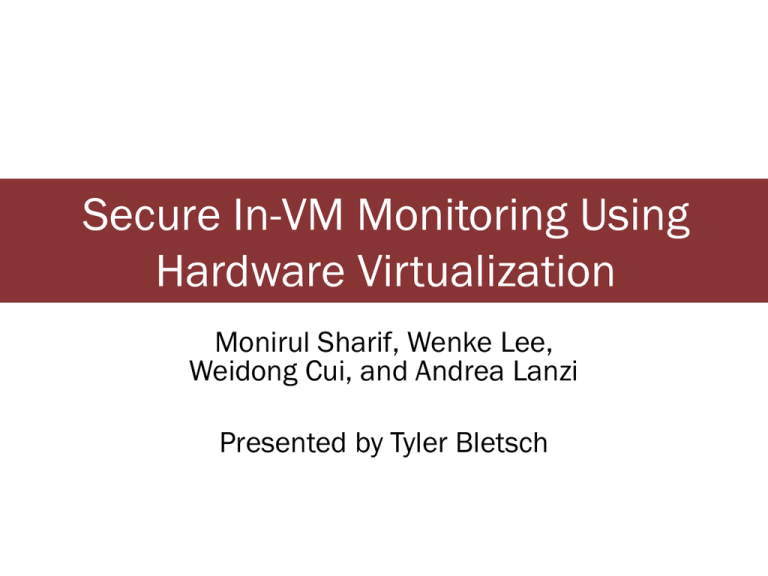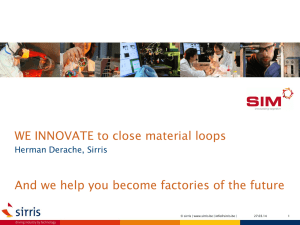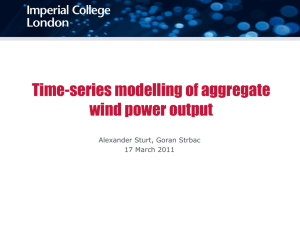Secure In-VM Monitoring Using Hardware Virtualization
advertisement

Secure In-VM Monitoring Using Hardware Virtualization Monirul Sharif, Wenke Lee, Weidong Cui, and Andrea Lanzi Presented by Tyler Bletsch Introduction • Problem: Kernel level rootkits can kill security monitoring software • Solution: Virtualization allows the monitor to live outside the VM • Problem: Out-of-VM monitoring can be very expensive – Why? 2 Out-of-VM monitoring Inspection DP CP K DK A Program data Program code Hook Hook data Adversary program H CM DM R Handler Monitor code Monitor data Response 3 Problem with out-of-VM monitoring • Significant performance impact – VM context switch is expensive – Introspection is hypercall-driven: expensive • We want a monitor without these problems • Performance guarantees: – (P1) Fast invocation: No privilege change for handlers – (P2) Data read/write at native speed: No penalty to access DM or DP 4 Solution: Secure In-VM Monitoring DP CP K DK A Program data Program code Hook Hook data Adversary program H CM DM R Handler Monitor code Monitor data Response 5 Security guarantees • Run the monitor inside the VM context, but provide out-of-VM-style security guarantees: – (S1) Isolation of monitor code CM and data DM: Adversary can’t access the monitor at all – (S2) Designated point for switching into CM: There’s only point entry point (tiny attack surface) – (S3) The handler is called iff the hook is triggered: The hook calls the handler; nobody else can – (S4) Behavior of M is not maliciously alterable: No dependency on monitored data or code 6 How to achieve this? • Separate address space with a one-way page table for the monitor • Small entry/exit gates into this address space – Invocation checker verifies that the call is legit 7 The SIM address space SIM Data/Code • The monitor itself • Visible only within SIM address space Invocation checker • Verifies call chain is legit • Visible only in SIM space Entry/exit gates • Visible in both • Writable only in SIM space • Tiny, well crafted Kernel code/data • Not executable in SIM space (can't accidentally run insecure code) 8 Changing the address space • CR3 register indicates page table directory – Hypervisor controlled • To avoid hypercall, use Intel CPU's "CR3_TARGET_LIST" to freely switch between: – P_SHADOW: Process's normal space – SIM_SHADOW: Restricted SIM space 9 Entry/exit gates • Only point of entry for SIM address space • Entry: – – – – – – Disable interrupts Save CPU state to the stack Switch address space Re-disable interrupts Switch stack to a SIM-restricted one Run invocation checker • Exit: – Restore stack, page table, CPU state – Re-enable interrupts – Jump to return point (usually the point of origin) 10 Invocation checker • Obviously can't rely on stack • Use CPU debug registers to track jump history • Lock these registers from modification by VM 11 Security monitor • Can't rely on untrusted code – No kernel functions, dynamic libraries, etc. • Need to traverse kernel data structures just like the out-of-VM technique (VMI) • Hardware access granted by hypervisor API 12 Performance requirements met? (P1) Fast invocation: Yes: No privilege change needed; just a page table switch (P2) Data read/write at native speed: Yes: Pages are mapped, accessed natively 13 Security requirements met? (S1) Isolation of monitor code CM and data DM: Yes: Monitor memory isn't mapped to the process space (S2) Designated point for switching into CM: Yes: Entry/exit points are the only way in (S3) The handler is called iff the hook is triggered: Yes: Hook calls handler; calls pass the invocation checker (S4) Behavior of M is not maliciously alterable: Yes: Untrusted code is non-executable in SIM space 14 Ah, but what if they... • Jump into the entry gate after the interrupt disable instruction (CLI)? – It gets re-disabled again after the page table switch • Switch to SIM_SHADOW directly? – The next instruction is no longer executable – But what if they do it right before a SIM page? •Any page after an unallocated address is made non-executable 15 Implementation • Linux KVM host, Windows XP guest • To initialize from a trusted boot state, a driver: – Reserves virtual address space for entry/exit gates – Has the hypervisor construct a SIM page table – Loads the security monitor into kernel space and has the hypervisor remap it into SIM space – Informs the hypervisor of each hook and handler; hypervisor generates entry/exit routines accordingly • Memory protection: – Don't check every time CR3 is changed, check new page table entries as they are created 16 Evaluation: Monitor invocation • Time to enter and exit a no-op handler – SIM: – Out-of-VM: 0.469 μs 5.055 μs • Factor of 10.7 improvement 17 Evaluation: Process creation monitor • Hook process creation • Traverse kernel data to find process name • Process must be on whitelist to proceed – If not, skip and return failure • Average time for process creation: – Traditional In-VM approach: 3.487 μs – SIM approach: 3.967 μs (+13.7%) – Out-of-VM approach: 28.039 μs (+690.5%) 18 Evaluation: System call tracing • Make note of every system call, emit trace every 10,000 calls • Macrobenchmarks from PCMark 05 suite Benchmark Memory Latency Bare Out-of-VM SIM overhead overhead 10.42 MAcc/s 84.58% 7.97% HTML Render 1.12 pg/s 52.42% 5.83% File Compress 3.4 MB/s 3.97% 0.59% File Encrypt 20.56 MB/s 7.85% 0.89% File Decrypt 78.21 MB/s 2.53% 0.45% HDD 15.29 MB/s 41.68% 3.74% 82.73 pg/s 128.84% 9.64% 46.10% 4.15% Text Edit Average - 19 Conclusion • SIM: The best of both worlds – Security of out-of-VM solution – Performance of traditional in-VM monitoring 20 Concerns • Very difficult to develop monitors – No libraries – No system calls – Porting a full-fledge anti-malware package? • Interrupt race condition in entry code? Normal entry Attacker entry CLI PUSHA MOV EAX, SIM_SHADOW MOV CR3, EAX Address space switch Interrupt now? CLI MOV [P_ESP] ESP MOV ESP, [SIM_ESP] JMP INVOKATION_CHECK 21 Discussion 22











